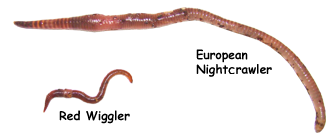Red Wiggler Worms - Perfect for Vermicomposting and Soil Enrichment
Red Wiggler Worms - Perfect for Vermicomposting and Soil Enrichment
Blog Article
Making Best Use Of the Perks of Red Wiggler Worms: A Comprehensive Manual for Home Gardeners and Urban Farmers
In the world of sustainable gardening techniques, red wiggler worms stand as unhonored heroes, silently transforming organic waste right into nutrient-rich spreadings that can function marvels for soil wellness. By discovering the complexities of just how to effectively care for and optimize the advantages of red wiggler worms, people can open a wealth of possibilities for boosting the sustainability and productivity of their gardening ventures.
Understanding Red Wiggler Worms
Red Wiggler worms, renowned for their effective composting abilities, are a species of earthworms commonly utilized in vermiculture techniques. These worms, scientifically understood as Eisenia fetida, grow in decaying natural product, making them ideal prospects for composting.
One trick attribute of Red Wiggler worms is their reproductive rate. These hermaphroditic creatures possess both male and female reproductive organs, enabling them to recreate quickly under desirable problems. A fully grown Red Wiggler can generate numerous children in a short duration, ensuring a steady populace within a composting system.

Setting Up a Worm Bin
When developing a worm bin for vermiculture objectives, appropriate preparation and focus to information are important for developing a conducive atmosphere for Red Wiggler worms. Begin by choosing a suitable container for your worm container.

Place the worm bin in a trendy, dark place away from direct sunlight and extreme temperatures. Regularly keep track of the moisture degrees, adding water if the bed linen really feels dry or half-cracked. Feed the worms a well balanced diet regimen of fruit and veggie scraps, staying clear of citrus fruits, onions, and spicy foods. By adhering to these actions, you can set up a thriving worm bin that will successfully process organic waste into nutrient-rich vermicompost for your yard.
Feeding and Preserving Worms
Guaranteeing a nourishing and balanced diet is essential for the health and efficiency of Red Wiggler worms in a vermiculture system. It is important to prevent feeding them citrus fruits, onions, garlic, dairy items, meat, and oily foods as these can be unsafe to the worms or create undesirable smells in the bin.
Appropriate dampness degrees are additionally critical for the wellness of Red Wiggler worms. By vigilantly monitoring their diet, moisture, and environmental conditions, home gardeners and metropolitan farmers can sustain a healthy and balanced and productive Red Wiggler worm population for composting functions.
Collecting Worm Castings
To successfully draw out nutrient-rich worm spreadings from the vermicompost, a systematic harvesting procedure is necessary for making best use of the composting benefits. The first step in harvesting worm spreadings is to urge the worms to move to one side of the bin.
After check here the castings have been collected, it is crucial to divide any type of staying worms he said from the castings to prevent harming them throughout storage or application. One reliable method is to create cone-shaped piles of castings under brilliant light. Worms will intuitively relocate far from the light, permitting simple splitting up and elimination.
Last but not least, the harvested worm spreadings need to be kept in a trendy, dark, and completely dry location to preserve their quality and performance as a nutrient-rich dirt modification. By following these actions, home garden enthusiasts and metropolitan farmers can make the most of the advantages of red wiggler worms in their vermicomposting systems.
Utilizing Worm Castings in Gardening
The consolidation of nutrient-rich worm castings into garden soil can dramatically improve plant growth and overall soil health. Worm spreadings, also called vermicast, are an all-natural plant food created by red wiggler worms as they break down raw material. These spreadings are abundant in vital nutrients like nitrogen, phosphorus, potassium, and valuable germs that advertise plant growth and boost dirt structure.
When utilizing worm castings in gardening, it is important to mix them completely into the dirt or use them as a leading dressing around plants. The slow-release nature of worm spreadings makes certain a consistent supply of nutrients to plants in time, reducing the threat of nutrient leaching and promoting long-term soil fertility. In addition, worm castings aid enhance soil oygenation, water retention, and microbial activity, producing a healthy and balanced environment for plant roots to thrive.

Verdict
In verdict, the utilization of red wiggler worms in home gardening and metropolitan farming can substantially profit soil health and plant development. By comprehending just how to set up and maintain a worm container, feed the worms appropriately, and harvest their nutrient-rich castings, garden enthusiasts can take full advantage of the benefits of these earthworms.
In the world of sustainable gardening practices, red wiggler worms stand as unsung heroes, quietly transforming organic waste into nutrient-rich spreadings that can function marvels for soil health and wellness.When establishing a worm bin for vermiculture functions, proper preparation and interest to detail are necessary for producing a helpful environment for Red Wiggler worms. The first step in gathering worm castings is to encourage the worms to move to one side of the container. Worm castings, likewise known as vermicast, are an all-natural fertilizer generated by red wiggler worms as they break down organic issue. By comprehending exactly how to set up and keep a worm bin, feed the worms appropriately, and harvest their nutrient-rich castings, garden enthusiasts can make the most of the benefits of these earthworms.
Report this page